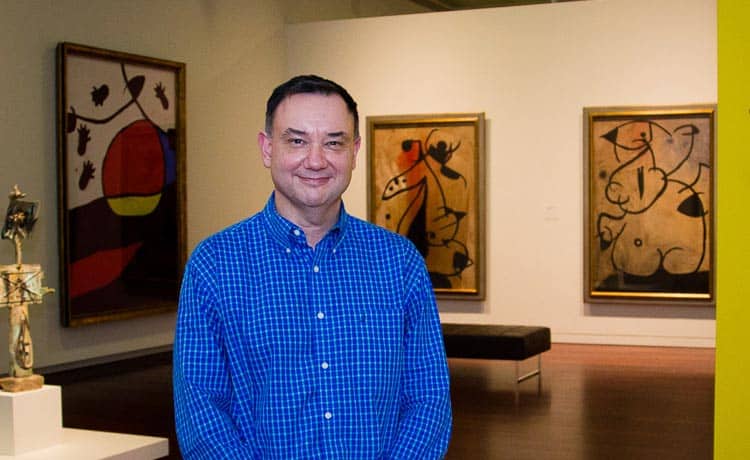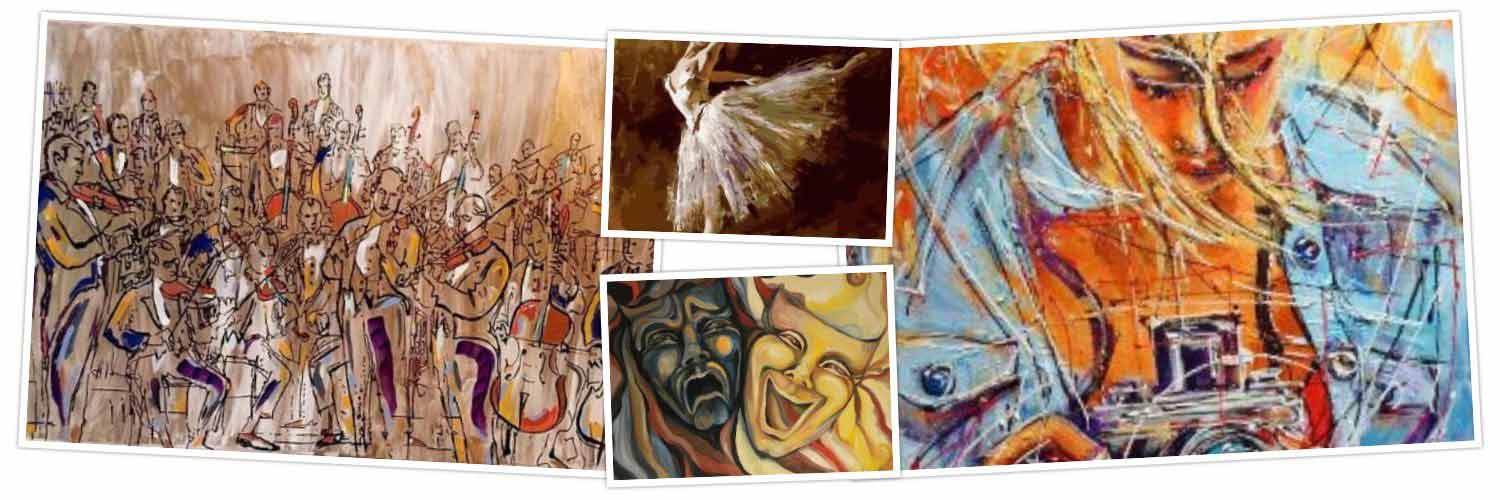Rene Barilleaux, Head of Curatorial Affairs at the McNay Art Museum
By JASMINA WELLINGHOFF, Editor
Please describe your job.
I oversee the McNay’s curatorial department, which includes our collection, our exhibitions program and our archives. It’s the content part of what we do.Our work involves working with the art, working with collectors, working with artists, working on acquiring and presenting works of art. And we work closely with our education department that does the more interpretive part of that.

How do you go about deciding what exhibits to present?
In general terms, our program is focused on American and European art from mid-19th century to the present. So those are our parameters. We consider the term “American” very broadly, so we also think of Canada, Mexico and Latin America as part of “America.” Also, there has been a growing interest here and across the world in more contemporary art. We think a lot about contemporary projects because it’s art of our time, but we also realize that there has to be a balance. When we look at our schedule, we combine things. If we do a contemporary exhibition here, maybe we should think of a more historical exhibition to follow it. Some exhibition ideas come from the staff, and some come from other places.
Which recent exhibits are you most proud of?
My recent two projects that I worked hard on coincided with COVID: last fall’s Robert Indiana exhibition and the current “Limitless” exhibition. Those two were a challenge simply because we were challenged by the time we live in. So, we had to really think about the way we presented the work – the layout, the interpretation, the way people move through the space. In both cases I feel that we offered exhibits without the “COVID-ness” coming through. We worked around the COVID part. It did not impact people’s experience of the exhibits.
The other recent exhibition that I was proud of was our “Transamerica” exhibition that dealt with gender and identity. That was in the summer of 2019.
How is the current show, “Limitless” faring?
Very well. It’s as interactive as it can be in the pandemic. We’ve done some special things to give it a fun-house feel. It’s kind of dark in the gallery; you approach things as if you were walking through an amusement park; there’s a lot of interactive work. Kids are very engaged by interactive pieces. And there’s a theatrical quality to the show. I think people respond to that. It’s gratifying to see people interact with the art.
How did you develop an interest and passion for the visual arts?
I started drawing before I was in elementary school. Throughout elementary and middle school, I liked to make stuff, to build things. In junior high I wanted to learn oil painting, so, I took books from the library on oil painting and bought oil paints, and taught myself how to paint. In high school, I had no art classes at all.
I was a senior in high school when I first visited a museum, the New Orleans Museum of Art. My first real training in art was in college where I was a studio art major, not an art history one. I wanted to be an artist… At 21, I left for New York City and enrolled in Pratt Institute for graduate school. By the time I was 23, I had an MFA in painting but I didn’t want to be a painter.
What made you change your mind after so many years?
As an artist you are isolated in your studio, doing your solitary thing. I realized I liked interacting with people, and dealing with art, but I no longer wanted to make it. While I was at Pratt, I had done a museum internship at the Cooper Hewitt Museum, and later got hired by that museum, and I worked my way up. So, that’s how I became a curator. (He later pursued jobs at other museums across the country and came to the McNay in 2005.)
How would you describe the contemporary art scene in San Antonio?
Since I came here 16 years ago, things have changed a lot. We have a new generation of artists. I see the scene as very vibrant, very connected to the world but also very community oriented. We are in the process of working on a show for next spring, which is going to feature nine San Antonio artists of the “next generation.” They are thinking about things differently. It’s exciting to watch them.
You have been including San Antonio artists in the McNay exhibits.
Right, that’s part of our strategic plan. We will be Introducing the work of local artists within the context of the collection and within the context of exhibits by other artists that we are working with. I feel all artists should be treated alike, whether you are a superstar or just starting out. The first San Antonio artist that I was aware of even before moving here was Jesse Amado. And I knew about Chuck Ramirez’s work and then learned about Dario Robleto. (Robleto later moved to Houston.) We recently showed the work of Ethel Shipton and Nate Cassie, and we also acquired a work of Katie Pell (who died recently).
If you could buy one piece by a contemporary artist for your home, whose work would it be?
I am a huge fan of artist Lynda Benglis. I would love to have one of her works. Unfortunately, we don’t have any of her pieces even here at the McNay.
You are a leader at the McNay, a boss. What traits and strategies help one to be an effective leader?
A leader should be fair, generous, kind, and should lead by example. To demonstrate what you mean, just do it. A leader should be patient and should welcome new ideas. And respect everyone on your team.
You have a very French name and you grew up in Louisiana. Tell us about your background.
My ancestors on both sides of my family are primarily French. My maternal grandmother was very French culturally, and my parents spoke French to each other at home. I do feel like there was this pervasive French culture that we lived in. And we were very Catholic. In south Louisiana you have the Cajun culture which is related to Canada, not to France. My ancestors were more French.
If you could meet someone from the past, famous or not famous, who would you choose to meet?
Saint Francis. (laughs) I love his sense of humility and the beautiful story of his life. And he loved animals!
Do you collect art?
I do, primarily contemporary American art. Most of the pieces, however, have a story behind them. That’s what all the works have in common, a narrative that comes with them, a memory, an occasion, a connection to something.
What other skills do you have?
I can cook very well. I am a good dancer.
Do you stick to a certain type of cuisine?
No, not really, but for company, I always like to cook South Louisiana food. It’s nice to share your culture with people.
What behavioral traits do you find annoying in other people?
Cruelty and arrogance; people who are stingy, not necessarily with money, but with their time, knowledge, with willingness to help.
And what do you appreciate?
I am into people who are warm and giving. And funny. Funny is huge. Whenever I hire someone, I always say, “A sense of humor is so important to me.” Here are the things I look for in the person I am hiring: flexibility, a sense of humor, and a willingness to do what needs to be done and never says “it’s not my job.”
What worries you at the moment?
What I worry most about is the immediate future. Prior to COVID, I used to worry more about the distant future. But now I wake up in the morning, anxious about the day ahead of me.
When do you think, life might return to normal?
I cannot predict that but I can tell you that I don’t see my life and work, and the world around me, returning to what it was before (the pandemic.) I think everything is going to be different.
So, what are you looking forward to?
Immediately? I am going to New York in two weeks. I haven’t done that in over a year, so, I am looking forward to it. I want to see what it’s like in the world outside of here because I’ve been so isolated here. Since COVID started, I have only been in Austin once. I am really looking forward to being able to travel freely, when travel is no longer a big issue. Coming up in the fall, there’s a major art fair in Switzerland, for instance, and I would like to go to Miami for the art fair in December. Next year is the Venice Biennale!
Is there something you would like to tell us about yourself that we did not ask?
Looking at where I am at my age and how I relate to people, my work and my staff -as opposed to how I was starting out and trying to build my career – I sense that I am a lot looser now, less rigid, less controlling. I allow other people around me to take things from me. By controlling less, you are actually creating more space for possibilities to happen around you. It took me a long time to get there, but I feel I am getting there now and it’s very liberating.
———————————————————————————————————————-
Current exhibit at the McNay: Limitless! Five Women Reshape Contemporary Art; on view through Sept. 19 (includes Infinity Mirror Room); for info and tickets go to www.mcnayart.org

Thank you for being a curator! Artists certainly appreciate your work on our behalf. Please consider my work for exhibition, BrendaKingeryartist.com
I loved your article about Rene Barilleaux. Your interview was excellent. You captured Rene’s personality, his education and his hopes and dreams perfectly.
Maggie